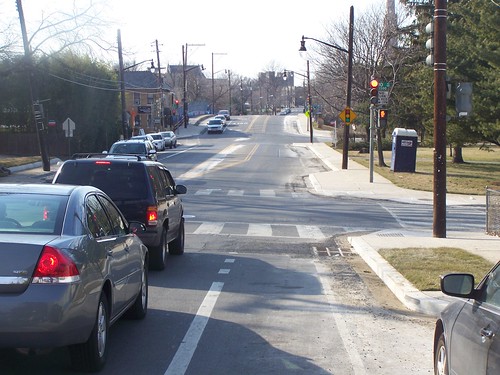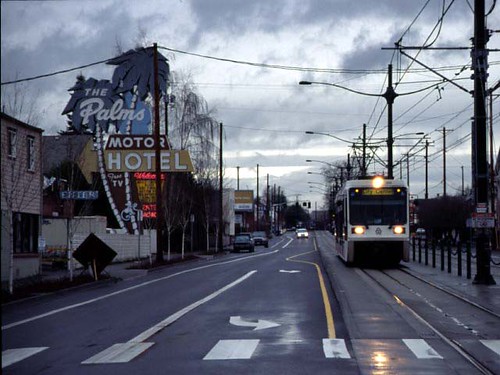(Road) Dieting is good for you and more specific car dieting options for the city
The Seattle Post-Intelligencer reports:
A recent study ["Evaluation of Lane Reduction “Road Diet” Measures on Crashes"] released by the Federal Highway Administration offers more evidence that rechannelizing four-lane streets to two lanes with a center turn lane can reduce collision rates without worsening congestion.
The study looked at "road diets" in several cities and suburbs in California and Washington, including Bellevue and Seattle. It also analyzed data from small towns in Iowa. The study looked at four-lane rechannelized similar to the city's proposal for Northeast 125th Street in North Seattle and other recent lane reductions on Stone Way North and Nickerson Street in which the fourth lane was converted to another use such as bike lanes or sidewalks.
The data from Washington and California showed a 19 percent reduction in collisions. The data from Iowa showed a 47 percent decrease.
Light rail in Portland. Flickr photo by fotojo.Urban road dieting
I think that some of the options for "road dieting" are different in traditional center cities, which often don't have the wide traffic sewers that we may typically associate with suburban driving conditions, but still prioritize the movement of motor vehicles over walking, bicycling, and transit in many ways, sometimes without realizing it.
What we might call "car dieting" options in the center city include:
- prioritizing bus transit service by providing dedicated on-street lanes and prioritization at traffic signals (dedicated lanes only work when they are in use a lot]
- deploying light rail and streetcar transit through in-street operations and traffic signal prioritization rather than operating on right of way separated from other vehicles
- converting one way streets into two way streets (e.g., during rush hours Constitution Avenue in NE DC used to function as a one way street in and out of the city, now it is two way without hour restrictions)
- converting street right of way into on-street cycle tracks for bicyclists
- changing pavement treatments, such as using Belgian block, in pedestrian priority areas, to provide visual, aural, and physical clues to drivers of motor vehicles that they should drive more slowly
- setting 30kph/40kph/50kph speed limits for motor vehicles such as was pioneered in Graz, Austria, and has since been taken up by cities throughout Europe and more recently in a number of the arondissements in Montreal.
- charging closer to market rates for on street residential parking permits -- Toronto does this, while I am unfamiliar with any prominent examples in the U.S.
- congestion charges such as those deployed in London or Stockholm. We have no such examples in North America at present.
- High occupancy vehicle requirements for at least one lane during rush hours on key inbound/outbound streets used by commuters. (I have promoted this idea for a few years now, but I didn't really think about it until reading a very old op-ed in the Washington Post by Patrick Hare, the same person who came up with the idea for DC's Metropolitan Branch Trail)
- angle parking -- this is a tough one. Angle parking adds parking inventory, but it does slow down traffic. However, it still prioritizes driving and can end up denying the use of precious right of way space for preferred bicycle accommodation treatments such as cycle tracks
- along with all the typical streetscape treatment design techniques ("Complete Streets" concepts) such as curb bulb outs and the like that work to better balance walking conditions vis-a-vis motor vehicles.

HOV 2 Lane in Alexandria, Virginia.

After seeing and using Montreal's version of cycle tracks--they do one cycle track with two lanes, rather than one dedicated cycle track for each direction--I am an even more fervent believer in cycle tracks. Plus I think their method is less expensive and is more practical given the number of bicyclists that typically bicycle in North American cities, which is much less than it is in the Netherlands or Denmark.

Traffic calming and pedestrian prioritization has been implemented in streetscape projects in the Brookland neighborhood of DC, such as on Monroe Street NE.
Labels: bicycling, car culture and automobility, urban design/placemaking, walking




2 Comments:
Thanks a bunch for sharing this with all people you actually recognize what you are talking about! Bookmarked. Kindly also discuss with my website.
diet and be active
Thanks for sharing such an amazing blog. Wish to read more from you. To know more visit Keto Diet Food Delivery Mumbai.
Post a Comment
<< Home